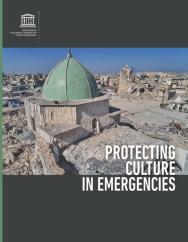
Disaster risk reduction for culture and designated sites
Natural hazards have caused extensive loss of life as well as damage to both tangible cultural heritage such as buildings and infrastructure and intangible cultural heritage such as social values, traditions, and attachment to a location. Natural hazards also impact World Heritage sites, which are important havens for cultural and natural heritage. Since disasters affect culture in all its forms, communities are more vulnerable during and after.
And yet, culture is also a driver of recovery in strengthening the resilience of a community.
The link between culture and resilience
Culture influences the way people perceive risk, their understanding of what a hazard is and how to react to it. It also shapes their response and resilience, informing how to prepare for and protect themselves from certain types of hazards when they occur. From there, culture also influences people’s risk indirectly because it impacts their livelihood choices, settlement location, social networks and availability for preparedness activities, including disaster risk reduction education. All of this influences a community’s vulnerability to natural hazards.
A growing number of natural hazards is causing serious damage to heritage sites and disrupting the cultural practices and knowledge dependent on these sites, thus undermining the resilience of the affected communities and their prospects of sustainable development based on local resources and capacities. Cultural and natural heritage is, therefore, both threatened by natural hazards and the key to increasing communities’ resilience. Both have a role in shaping how communities prepare, act and respond to disasters by helping communities reduce their exposure and implement the necessary changes to adapt to risks, including the impacts of climate changes. UNESCO protects and uses tangible and intangible cultural and natural heritage as platforms with a tremendous potential to share and implement disaster risk reduction knowledge, in order to enhance communities’ resilience to natural hazards and ensure no one is left behind.
Through the implementation of its mutually reinforcing Culture Conventions, UNESCO works with the international community to protect culture and promote cultural pluralism in emergency situations by implementing activities in times of conflict as well as in the wake of disasters. In this context, UNESCO has paved the way in adopting the 2015 Strategy for the Reinforcement of its Action for the Protection of Culture and the Promotion of Cultural Pluralism in the Event of Armed Conflict.
Culture must not be forgotten, which is why UNESCO also works with national governments on their disaster risk reduction policies to include cultural elements to protect and strengthen it around the world.
Tangible cultural heritage
Concluding the development of a data-driven and community-based resilience improvement of historic areas
Building disaster resilience to protect our past
Connecting education, culture, and disaster risk reduction


Youth and community actions for cultural preservation

Disaster risk reduction in natural heritage sites
World sites may be partly or entirely exposed to natural hazards and extreme weather events, with potential impacts on the communities living in or near the sites, and on their livelihoods. Due to the cultural and symbolic value of designated sites, their loss, or damage, can resonate across the world.
At the same time, these iconic sites have tremendous potential as platforms to share knowledge on disaster risk reduction. Many designated sites have community and tourism-oriented programmes to raise awareness about the source of natural hazards, associated risks and ways to reduce the impacts.



